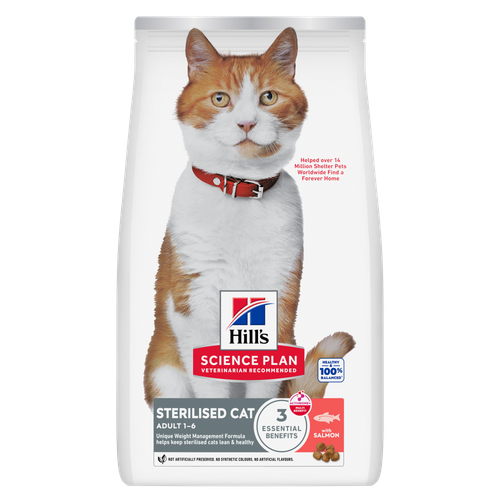
-
Find the right food for your petTake this quiz to see which food may be the best for your furry friend.Find the right food for your petTake this quiz to see which food may be the best for your furry friend.Featured products
 Perfect Weight Small & Mini Adult Dog Food
Perfect Weight Small & Mini Adult Dog FoodHill's Science Plan Adult Small & Mini Dog Food with Turkey is a complete premium pet food for adult small dogs from 1 year old that are prone to weight gain or slightly overweight. This deliciously smooth mousse is formulated to deliver the appropriate amount of energy to support weight maintenance in adult dogs.
Shop Now Perfect Digestion Small & Mini Adult Dog Food
Perfect Digestion Small & Mini Adult Dog FoodHill's Science Plan Perfect Digestion Small & Mini Adult Dog Food with Turkey is a complete premium pet food for small breed adult dogs aged 1–6 years. This deliciously smooth mousse is precisely balanced to deliver the appropriate amount of energy and to support digestive health in adult, small breed dogs.
Shop Now Sensitive Stomach & Skin Dog Food
Sensitive Stomach & Skin Dog FoodHill's Science Plan Sensitive Stomach & Skin Adult Wet Dog Food with Chicken is a complete premium dog food for adult dogs from 1 year. This savoury tinned loaf is enriched with ingredients that support digestive health & skin care.
Shop NowFeatured products Sterilised Adult Cat Food
Sterilised Adult Cat FoodHill's Science Plan Adult Sterilised Cat Dry Food with Salmon is specially formulated with ActivBiome+ Multi-Benefit Technology. It is a precisely balanced nutrition, tailored to meet the needs of sterilised cats, to help keep them lean & healthy.
Shop Now Sensitive Stomach & Skin Adult Cat Food
Sensitive Stomach & Skin Adult Cat FoodHill's Science Plan Sensitive Stomach & Skin Adult Wet Cat Food with Turkey is a complete pet food for adult cats, aged 1–6 years. This highly digestible wet food comes in a pouch and supports healthy digestion, as well as nourishes skin and promotes a thick and lustrous coat.
Shop Now Hairball & Perfect Coat Adult Dry Cat Food with Chicken
Hairball & Perfect Coat Adult Dry Cat Food with ChickenHill's Science Plan Hairball & Perfect Coat Adult Cat Food with Chicken is formulated to effectively help avoid hairball formation in adult cats while promoting a beautiful coat. Thanks to its mix of essential omega-6 fatty acids, this food benefits the cat's skin and fur, keeping them healthy and shiny. Our Advanced Fibre Technology helps reduce hairballs by naturally promoting their passage through the gut. This food is formulated with high-quality protein for a perfectly balanced, great-tasting recipe.
Shop Now -
Dog
- Dog Tips & Articles
-
Health Category
- Weight
- Food & Environmental Sensitivities
- Urinary
- Digestive
- Joint
- Kidney
-
Life Stage
- Puppy Nutrition
- Adult Nutrition
- Senior Nutrition
Cat- Cat Tips & Articles
-
Health Category
- Weight
- Skin & Food Sensitivities
- Urinary
- Digestive
- Kidney
-
Life Stage
- Kitten Nutrition
- Adult Nutrition
Featured articles An Owner's Guide To Safe Water Sources For Pets
An Owner's Guide To Safe Water Sources For PetsEnsure your pet's hydration with our owner's guide to safe water sources for pets. For detailed tips on maintaining your pet's health, visit Hill's Pet UK.
Read More Virtual Vet Visits: What You Need to Know
Virtual Vet Visits: What You Need to KnowLearn the ins and outs of a televet appointment before you talk to a vet online.
Read More Tips For Mixing Wet And Dry Pet Food
Tips For Mixing Wet And Dry Pet FoodDiscover tips for mixing wet and dry pet food to ensure balanced nutrition and variety for your pet. For comprehensive feeding advice, visit Hill's Pet UK.
Read More -



Unlike dogs, who will often jump at the chance of a car ride, cats aren't really interested in joyrides – often quite the opposite. Their home is their kingdom and leaving the castle can be stressful. However, with the best will in the world, sometimes cats have to travel. You may need to take your cat in the car to the vet’s or to a cattery while you go away, or you may decide to take them on holiday with you. (Please consider this carefully and discuss it with your vet. Your idea of a relaxing holiday may not be the same as your cat’s!) You may even need to travel with your cat on a train or a plane. Whatever the reason for the journey, one way to alleviate the stress (for both of you) is to create a cat travel checklist of items that will keep your cat comfortable, happy and healthy on the road.
Cat Carrier and bedding
The safest way for your cat to travel, even on short trips, is in a cat carrier. A sturdy carrier not only protects your cat from possible impact, but also avoids the real danger of them getting tangled up in the driver's feet and the pedals. A hard plastic model is a good choice for cat travel, and buckling it in the backseat with a seat belt adds an additional layer of safety. Be sure to face the carrier looking out so your cat can check out the world around them. If they display anxiety, place a towel or blanket over the gated door to block their view. The carrier should be big enough for them to sit and stand comfortably, as well as turn around, but not so big that they have room to roam. A carrier that is too big could result in injury if your vehicle is involved in an accident or you have to brake suddenly.
Remember to make sure your cat is as comfortable as possible with a familiar blanket or cushion so that the carrier smells like home and they can snuggle up as best they can. If your cat is going somewhere for a longer period of time, you may want to take another, larger, more luxurious bed for them. This is also useful in case your cat gets scared and soils the carrier during your journey.
Food and water
Pack your feline friend's favourite cat food. It’s best not to decant cat food out of its bag because it stays fresher if you squeeze the air out and reseal it after each meal. Ensure you take enough for the duration of your trip, bearing in mind you may need more than one bag, and a bit extra in case of unforeseen circumstances. Make sure you have enough water for your cat as well as the human passengers so that everyone can stay hydrated.
An inexpensive DIY pet travel bowl is ideal for travel. You can keep a small bowl of food in their container in case they get hungry. It's best to start with small amounts of food to make sure they won't get sick in the car, before giving them their normal daily amount. Save the rest for when you reach your destination. Don't forget to bring their favourite cat treats to reward them for being good, and console them when they feel cooped up.


Tasty Tips
Litter box or tray
Cats usually need to feel safe, secure and secluded to use a litter tray. This means most cats will do their utmost to contain themselves even on long journeys. If you’re going on a particularly long journey, you should still offer your cat the chance to relieve themselves and have a break every 2-3 hours.
If your cat is used to using a tray, then take the one they are used to and the same litter they use at home. Whether they routinely go outside or not, it may be worth getting them used to using a covered tray at home in the week or two prior to the trip. This way they may feel more comfortable using it on the road.
Most importantly, you must make sure that your cat can’t escape when being offered these breaks. Make sure all the doors and windows of the car or camper van are firmly closed. If your cat gets frightened and bolts, you may never see them again.
Toys
You don't need to bring your entire arsenal of toys when travelling with a cat. Instead, stock up on a few old favourites and add a few new playthings to keep their interest. Because you'll be in such close proximity, avoid noisy, jingling toys. The commotion could drive you a bit crazy. Remember, the key to successful cat travel is happy and stress-free for you, too!
It's also a good idea to take some time to play with them when you've stopped so they can get their exercise. Spending all day sitting in their cat carrier won’t be much fun for them and they’ll want to stretch their legs. Again, make sure these breaks are in a safe environment.
Scratch post
It might seem a bit excessive to bring along something for your cat to scratch while you're on vacation, but scratching is a really important part of cat behaviour that they will want to indulge in wherever they are. In fact, they may be more likely to do it in a new place to make themselves feel at home and more relaxed. It’s better for all concerned if they do that on their own scratch post rather than on some expensive furniture at the hotel or house you're staying at.
ID and photos
Whether your cat wears a collar with an ID tag or not, it’s worth having your cat microchipped. It’s often mandatory to have your cat microchipped, and even if it’s not the law where you live, it’s the safest way to make sure you and your cat will be reunited if they escape. Collars can come off and ID tags can too. If your cat does escape, have recent photos on hand to share with locals as well as on social media.
Veterinarian contact information
In today's world with smartphones, this may be something that you can access on the go, but if you reach an area on your trip without a great signal, you will want to be able to contact a veterinarian in case something happens to your cat. It is a good idea to keep your normal veterinarian's contact information with you to call to let them know, but you should also do some research ahead of time to find a vet at your vacation destination. This will make life much less stressful than trying to find a good vet after something has happened to your cat.
Multiple cats
If you have multiple cats that you are planning on bringing with you, it’s best to have separate carriers for them to ride in, even if they are used to spending time together. This, again, will help keep them safe in case of an accident. It can also prevent them from getting tired of having to constantly climb over one another to get comfortable.
Using a cat travel checklist to prepare for your trip will ensure you don't forget anything you need to keep your cat happy and healthy.


Christine O'Brien is a writer, mom, and long-time cat parent whose two Russian Blues rule the house. Her work also appears in Care.com, What to Expect, and Fit Pregnancy, where she writes about pets, pregnancy, and family life. Find and follow her on Instagram and Twitter @brovelliobrien.
Related products

Hill's Science Plan Adult Sterilised Cat Dry Food with Salmon is specially formulated with ActivBiome+ Multi-Benefit Technology. It is a precisely balanced nutrition, tailored to meet the needs of sterilised cats, to help keep them lean & healthy.

Hill's Science Plan Sensitive Stomach & Skin Adult Wet Cat Food with Turkey is a complete pet food for adult cats, aged 1–6 years. This highly digestible wet food comes in a pouch and supports healthy digestion, as well as nourishes skin and promotes a thick and lustrous coat.

Hill's Science Plan Hairball & Perfect Coat Adult Cat Food with Chicken is formulated to effectively help avoid hairball formation in adult cats while promoting a beautiful coat. Thanks to its mix of essential omega-6 fatty acids, this food benefits the cat's skin and fur, keeping them healthy and shiny. Our Advanced Fibre Technology helps reduce hairballs by naturally promoting their passage through the gut. This food is formulated with high-quality protein for a perfectly balanced, great-tasting recipe.

Hill's Science Plan Perfect Digestion Cat Food with Chicken & Brown Rice nourishes your cat's unique microbiome and helps them reach their full potential.
Related articles

Feeding time can be a wonderful bonding opportunity for you and your cat. Find out how to make the most of it and create a healthy habit with HIll's Pet UK.

Find the right Hill

Find out about how you can support your cat's digestion to boost overall health. Diet is key to a long and happy life for your cat, so discover what you can do.

Discover what you can do to spot and support a sensitive cat stomach. See what routines and food you can implement to help your cat be happy and healthy.

Put your cat on a diet without them knowing
Our low calorie formula helps you control your cat's weight. It's packed with high-quality protein for building lean muscles, and made with purposeful ingredients for a flavourful, nutritious meal. Clinically proven antioxidants, Vitamin C+E, help promote a healthy immune system.
Put your cat on a diet without them knowing
Our low calorie formula helps you control your cat's weight. It's packed with high-quality protein for building lean muscles, and made with purposeful ingredients for a flavourful, nutritious meal. Clinically proven antioxidants, Vitamin C+E, help promote a healthy immune system.

